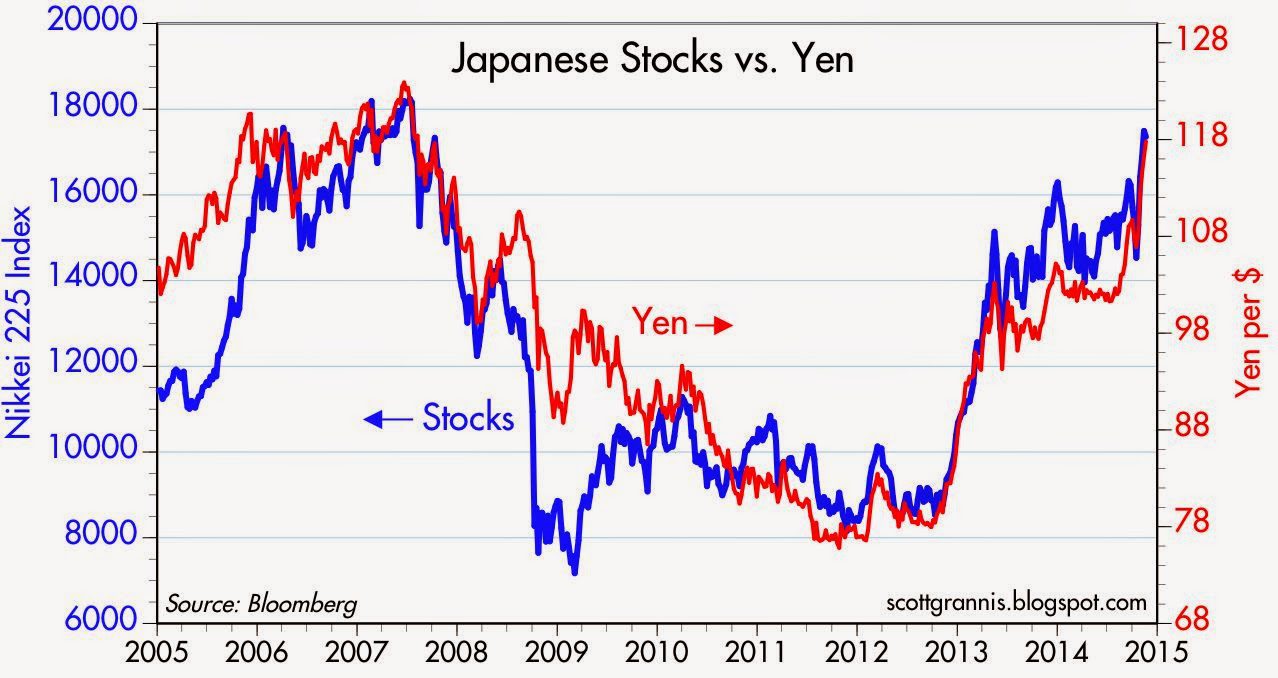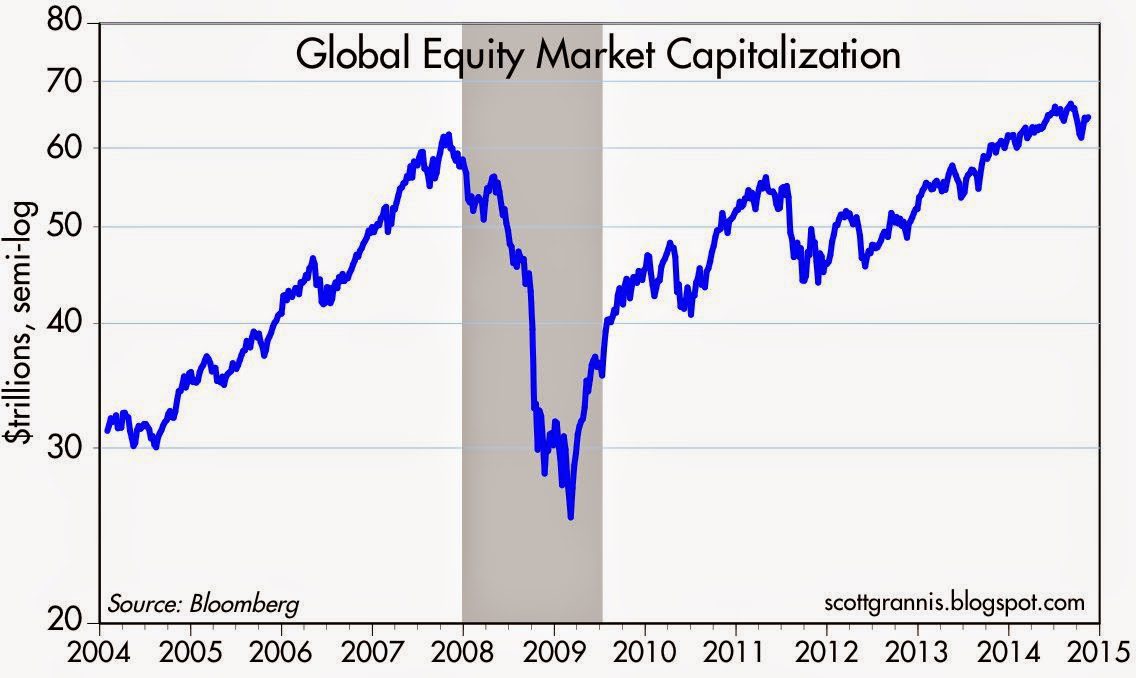A lot of people are thinking that if policy can’t stimulate, and demand is weakening on the margin then it’s time to really start worrying but I’m not so sure it’s time to run for cover. Here are 3 reasons why.
the margin then it’s time to really start worrying but I’m not so sure it’s time to run for cover. Here are 3 reasons why.
The above introductory comments are edited excerpts from an article* by Scott Grannis (scottgrannis.blogspot.ca) entitled Why the global gloom?
Grannis goes on to say in further edited excerpts:
- China’s economy has slowed from double digit growth rates to 7%,
- Japan has suffered two quarters of negative GDP growth,
- the Eurozone economy has grown by less than 1% in the past year and
- the U.S. economy has barely managed to exceed 2% annual growth for the past five years,
and people worry about the future since:
- the Fed seems almost certain to begin raising interest rates within the next 3-6 months
- industrial commodity prices are down almost 10% in the past six months,
- oil prices have plunged almost 30% since last June and
- high-yield credit spreads have risen over 140 bps since June, reflecting a loss of confidence in the future of corporate profits.
which are all (supposedly) signs of weaker demand.
- short-term interest rates are near the zero bound in Europe, Japan, and the U.S.,
- quantitative easing hasn’t done much at all to stimulate the U.S. economy, and it’s unlikely to be a miracle cure for the Eurozone economy.
- The Bank of Japan has managed to ease by enough to push the yen down by almost one-third against the dollar, but a hike in Japan’s sales tax seems to have swamped any stimulus from stronger exports.
- Genuine stimulus (e.g., tax reform, tax cuts, and reduced regulatory burdens) is being discussed almost everywhere, but it’s not likely to happen any time soon.
- In the past two years, the yen has plunged against the dollar, and the value of Japanese equities has doubled, both in seeming lockstep.
- Even in dollar terms, the Nikkei 225 is up over 30% in the past two years.
It’s hard to deny that something big is going on here, even though the Japanese economy shrunk in the six months ending September.

Have you noticed that no one seems to be talking about the “wealth effect” anymore? That’s the theory that says:
- an increase in stock prices and/or housing prices can induce consumers to spend more because they have become wealthier and that
- increased spending has the effect of strengthening the economy, or so the theory goes.
The above has never made much sense to supply-siders, however. You can’t spend your way to prosperity. Prosperity only comes as a result of more work, more investment, and/or more risk taking. The “wealth effect” theory assumes that stock prices just happen, or that they can be pushed up by easy money. In turn, higher stock prices cause more spending, which grows the economy and validates the higher stock prices.
2. Global Equity Market Capitalization Has Grown by 30%
Not so, in supply side theory. The stock market, like the bond market, is difficult to fool. Easy money doesn’t just magically raise stock prices, and higher stock prices don’t then stimulate the economy. More likely, stock prices rise as a result of improving economic and financial market fundamentals. Higher stock prices discount rising future earnings. Stock prices are the barometer of the economy’s future health, not a by-product of easy money.
Consider the implications of the chart below. It shows that:
- the market capitalization of the world’s equity markets has increased over $40 trillion dollars since March 2009, and
- in the past two years the value of global equities is up about 30%.
That’s a huge, and welcome increase. Does it mean that consumers are going to be spending double and triple as much because stock prices have almost tripled? No. It means that the expected future cash flows of corporations all over the globe have increased significantly. Consumers likely will be spending more in the future, but only because corporations will be making more and better stuff, hiring more workers, building new plant and equipment, and booking rising profits.

The stock market is often able to look across the valley of despair and see a better future on the other side. It’s likely that that’s the case today.
3. U.S. & Eurozone Equities Are Up Considerably
As the chart below shows, U.S. equities have greatly outpaced their Eurozone counterparts in the past four years.

…In the two years since Japan’s equity market suddenly came to life, U.S. equities are up almost 50%, and Eurozone stocks are up a little over 30%. In dollar terms, Eurozone equities are up about 20%. That’s not chickenfeed.
Conclusion
It’s hard to get pessimistic about the future when the world’s stock markets are becoming more and more optimistic. Of course, it’s hard to see significant improvements anywhere right now, but in my experience it sometimes takes awhile before the average person realizes the extent to which economic conditions have actually improved. For now, the world’s stock markets are seeing better times ahead, and investors seem to be getting the message.
Despite all the gloom out there…there is reason to be optimistic. If we’ve learned anything in the current recovery it’s that…government policymakers cannot conjure up prosperity by spending more money or cutting interest rates. What’s needed is for government to get out of the way and boost incentives for the private sector to jump-start the economy. That means lowering marginal tax rates, simplifying tax codes, eliminating subsidies, and reducing regulatory burdens.
This is not rocket science. The entire world has witnessed massive, almost laboratory-type experiments in fiscal and monetary stimulus fail to deliver the promised results. There’s nothing left to try except what is most likely to work: politicians need to hand the reins over to the private sector and market forces and step aside. The world’s stock markets seem to be saying that this is a real possibility that may come to fruition within the foreseeable future.
Editor’s Note: The author’s views and conclusions in the above article are unaltered and no personal comments have been included to maintain the integrity of the original post. Furthermore, the views, conclusions and any recommendations offered in this article are not to be construed as an endorsement of such by the editor.
If you liked this article then “Follow the munKNEE” & get each new post via
- Our Newsletter (sample here)
- Twitter (#munknee)
This article examines 5 fairly exciting things going on which, at the very least, could keep the U.S. economy from slumping, and enable equities to continue to climb. Read More »
2. How Favorable Are Conditions For Stock Market? You’ll Be Surprised
Our “Barnyard” analysis from a year ago resulted in 6 out of 8 points indicating that the market would be favorable over the next 6-18 months. That has come true, with the S&P 500 up nearly 20% since then. We expect many will be surprised by the latest Barnyard Forecast which we present below. Read More »
3. What Are the Most Important Stock Market Drivers Forecasting?
In our view, the four primary drivers of market valuations are earnings, dividends, interest rates and inflation, of which two stand out above the others as being the most important. We look at each factor and then conclude with what it means for stocks. Read More »
4. Is the S&P 500 Overvalued? Here’s an Assessment
The S&P 500 has rallied for three years in a row, without a significant correction. This puzzles many observers who consider equities to be overvalued. Many experts predicted a correction (or worse) this year – after predicting one last year which has not happened – so how high is the S&P 500 valuation, after all? Read More »
5. Don’t Fear End of QE or Beginning of Higher Interest Rates – Here’s Why
The Fed and the bond market are responding appropriately to declining risk aversion and a somewhat improved economic outlook. There is no reason to fear the end of QE or the beginning of higher short-term interest rates. Let me explain further. Read More »
6. Are We In A Pre-crisis Period? A Look At 8 Possible Triggers
The frequency of financial crises and recessions is quite high: on average, there is one crisis every 58 months (using data from the US National Bureau of Economic Research). In other words, statistically speaking, we should expect the beginning of the next crisis in April 2015, which would end by March 2016. There are 8 possible scenarios that could cause the next crisis. Let’s take a look at each. Read More »
 munKNEE.com Your Key to Making Money
munKNEE.com Your Key to Making Money


